
The short answer:
- Koi need ample space to thrive – When estimating pond size, you need at least 300 gallons per fish. For example a 3000 gallon pond could house no more than 10 koi.
- Great water quality – this can be accomplished through various types of filtration system.
- Protection from predators
There is nothing more relaxing and calming than sitting by the ponds edge watching the kaleidoscope of colors dance just below the surface as the graceful koi move about. There is something magical about these fascinating creatures.
I got the koi “bug” shortly after I caught the pond bug. It seemed to be the natural progression of things. If you are in the same situation, then you know what I am talking about. What started out as a mild curiosity has grown into a grand obsession.
I ponder such things as how koi can survive the harsh winter months. How a mere “fish” can be taught tricks, and actually learn things. The different personalities they possess. Koi are more than mere fish, they are extraordinary beasts that have an aura of magic, legend and lore that come with them.
Caring for koi properly begins with proper pond design. The old thinking that koi will grow to the size of their environment is false. They will grow to the size they are going to be regardless of the size of the pond. If you plan on keeping koi, the size of the pond must allow for this.
Pond Design
The right design is key to not just keeping these animals, but allowing them to thrive. Koi can reach lengths of 30” or larger depending on the breed.
When designing your koi pond, It’s important the depth of their environment is greater than their length. Just like you and I, koi also need exercise. If they do not have the proper depth, they cannot exercise their fins properly by swimming up and down.
A proper environment should have a depth of at least 42”. This will not only allow them proper exercise, but also allow them to survive in colder climates. Depending on what part of the world you live, the frost line needs to be one of the determining factors of how deep your pond will be. The depth of your pond should be well below the frost line for your part of the world.
If your pond freezes solid, this could spell sudden death for your koi. Regardless of 42”, your pond should also be deeper than the frost line. If both of these criteria are met, then you will have success caring for these creatures.
Water Flow
Most pond kits (link to amazon for the most up to date prices) do not come with a bottom drain. Even if the kit is labeled a koi pond kit, without a bottom drain it may not suffice for optimal water quality. The bottom drain (affiliate link to amazon for a bottom drain to add to a pond kit) helps to take some of the maintenance work out of the equation. When set up properly the current in the pond forces most of the sediment and waste to the bottom drain where it can be removed and filtered out.
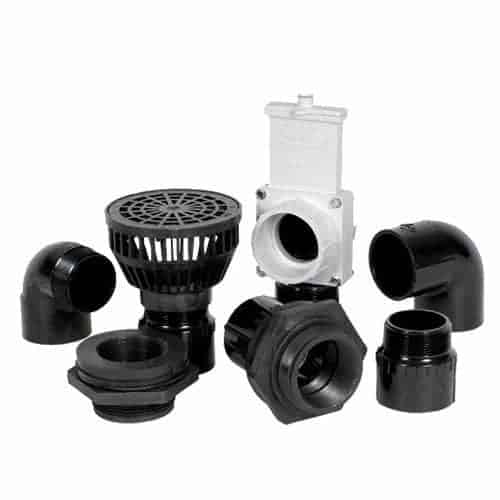
bottom drain kit 
rubber liner 
pond kit 
pop up bottom drain
Without a drain set up you will need to vacuum and remove the waste manually. Save yourself some work and design this out of the equation. Not only will it save you work down the line but your koi will be happier and healthier with a cleaner environment.
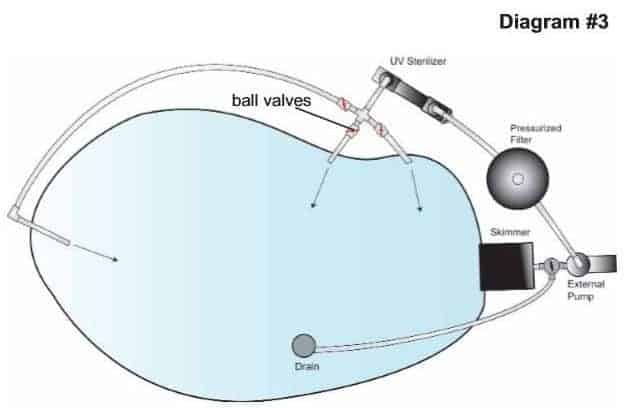
A proper koi pond setup contains a skimmer, bottom drain, and multiple return lines to create a swirling effect in the pond as seen in the illustration above. This swirling effect moves waste and debris to the center of the pond where it can be removed by the bottom drain.
The main differences between a water garden and a koi pond is the use of a bottom drain, and the filtration set up. The key to keeping koi is superior water quality. That being said the key to superior water quality is proper filtration.
What Filtration Do You Need
Gravity flow filtration systems are extremely effective keeping water crystal clear and koi healthy. The reason they work so well is the water flows steadily and slowly to the bottom drain. The key words are slow and steady.
The reason behind this is to move the waste, especially the large waste that settles to the bottom and keep it intact to the first chamber of filtration, ironically known as the settling chamber.
A gravity flow filter consists of different stages or chambers. Each chamber with different water levels. Water is always seeking its own level. A pump (link to my pond pump reviews) is placed after the final chamber pulling the water through the system and back into the pond.
One challenge of the gravity filter is the fact that the water level in the chambers must be slightly below the water level in your pond. Hence the term gravity filter. Since water always seeks to find its own level, the pond pump is merely used to pump the water back into your pond, and gravity pulls the water through the system.
The water enters at the bottom of the chamber, flows upward through filter media, then into another pipe at the top and into the bottom of the next chamber.
The filter media gets finer and finer as the water flows from one chamber to another. Most of the particulate is removed with this system, returning crystal clear water to your pond.
One downside to this system is the space it requires. Keep this in mind when designing your pond layout. It will be necessary to have ample space for this and a creative way to hide it.
The cycle the water flows for filtration is as follows:
Bottom drain into settling chamber to mechanical filtration to pump, and finally back into the pond.
Below is an illustration of this type of system.
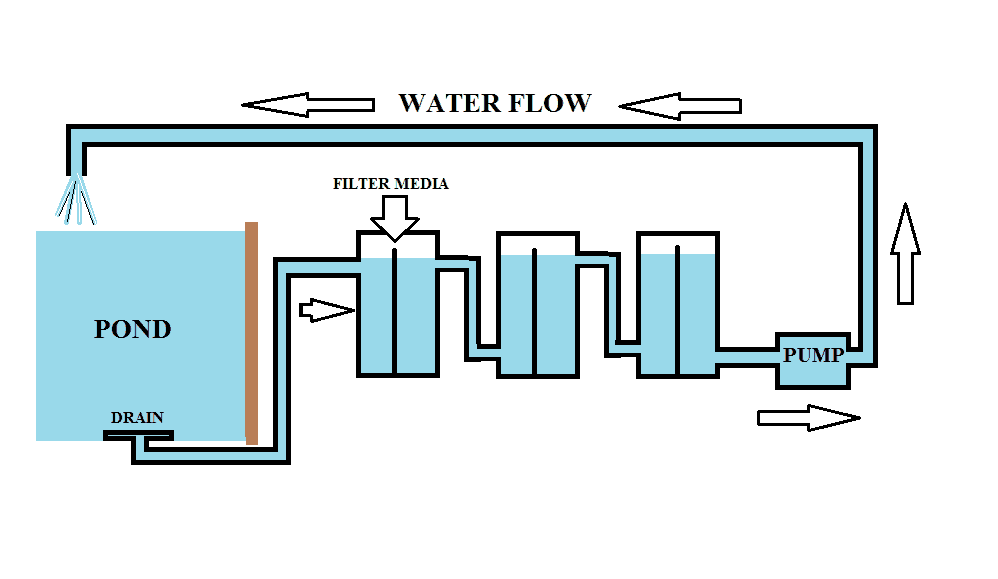
Other Filtration Systems
There are other methods of filtration that can be incorporated into your koi pond filtration system. Each will also require ample space and need to be hidden behind the scenes while at the same time easily accessible.
The typical pond kit does not have a bottom drain. It consists of a skimmer box (affiliate link to amazon for our recommended skimmer box) with a mesh net and filter media. The skimmer box also houses the pump. Water is then circulated to a waterfall unit where it flows through more filter media, and returned to the pond.

waterfall unit filtration 
skimmer box
Koi can be kept with this style of pond setup, however it may require more hands on maintenance throughout the season. For example the netting and the filter media will need to be cleaned on a regular basis.
The differences between these filtration systems is how the water flows through them, and how thoroughly they can remove particulate. All of them require a pump of some sort. Some of the best filtration systems use a combination of both gravity and power to achieve exceptionally clean, clear water.
This is the golden rule, you can have as many koi as your filtration system will allow.
Once you have decided on the pond size, type of your filtration system and how to implement the whole thing into your landscape, the next decision is what is the overall feeling you are trying to create in the space.
The typical koi pond has the black liner along the sides and bottom. This really makes the colors of these beautiful fish stand out. Another advantage of having only the liner exposed is for the ease of debris to make its way to the center drain for filtration. Having a smooth bottom allows the water to flow more completely in the environment without getting hung up on rocks.
The koi pond edge is where rocks come in. A shelf should be excavated approximately 12 inches from the water surface and rocks or other edging material should be used. The liner should go across this “shelf” and hidden up behind the rocks on the edge.
The pond built in our how to build a pond guide has the sides and bottom covered with rocks. Check out the link above to do this properly. The rocks make it a bit more difficult to clean, however it has a very natural look that easily blends into the landscape.
Your ponds edge and liner should be slightly higher than the surrounding grade to prevent rain runoff from entering your pond.
Quick side note: Depending on your budget you may not use a liner at all and choose to have your pond made of gunite, the same material that is used for swimming pools. For the sake of discussion, we are not going to elaborate on this any further because this method is beyond the scope of the DIY’er. This method requires professional installation and specialized equipment.
Most of my clients prefer the look of a natural rocked in pond if their budget allows. It is still possible to keep koi without the use of a bottom drain as mentioned earlier.Keep in mind that more maintenance will be required to keep the water quality high.
to keep the water at the highest quality a UV light should also be installed into the system. More on that here. The UV light will sterilize the water and kill any bacteria, or algae that passes through it.
Design Variations
A raised koi pond is another method of building a koi pond. A liner can be used in this as well. The only limitation with this is the depth you choose. Be sure it follows the guidelines discussed earlier so your koi can survive whatever type of winter you experience in your part of the world.
The raised type of pond can have two variations. The first is a completely raised pond. Think of it like an above ground pool. This would be constructed of cinder blocks and covered with a veneer of your choice.
The part that is seen above ground can be constructed of cinder blocks and lined with an EPDM liner (affiliate link to amazon for the best price on pond liners). This serves as a very effective means to create your pond. It will have a more modern formal look. The variation you choose will depend on the surrounding design of your outdoor space, and your taste.
Depending on your décor, tile, stone, wood, or even bamboo are just a few great choices to finish off your raised pond. The raised pond is ideal for warmer climates, where a frostline is minimal.
If you live in a colder climate like I do, you can still have a raised pond but will need to modify it a bit. It will be constructed in the same way above ground, but excavated well below the frost line.
Koi Ponds In A Cold Climate
When waste collects, it creates an environment that depletes the oxygen in the water as it breaks down. If the debris and waste is not removed, this unhealthy environment will be at the bottom of your pond.
Guess where your koi go in the winter months? Down at the bottom where there is less oxygen.
This could potentially suffocate your fish if the pond freezes over and the poisonous gasses cannot escape.
To avoid this simply add an aerator (affiliate link to Amazon for the best price) to your pond at a shallow depth. Placing the aerator at the bottom of the pond will introduce cold air at the bottom creating an unhealthy environment. The movement from the aerator will keep the surface from freezing solid and allow the poisonous gasses that build up escape.
A pond heater (affiliate link to Amazon) is another option if your part of the world is exceptionally cold. This keeps a small portion of the surface melted allowing the gases to escape.
Keeping the bottom as clear from waste as you can is imperative to the health and longevity of your beautiful fish.
A third option to deal with old man winter is to place your koi in holding tanks over the winter months, out of the severe weather. It is not necessary to keep them warm, just keep them out of the elements where they could freeze.
Disease And Your Koi Pond
Koi, being as hardy as they are can usually fight off any infections that would be brought on by fungi, or bacteria. Stress is the main cause for disease in your fish. This type of stress is not from an aggressive boss, or getting stuck in rush hour traffic. This stress is caused by water quality.
Water quality can be compromised by:
- Stress
- Placing sick fish into your pond
- Overcrowding
- Outside contaminates
- Spawning
Just like with any ailment, catching it in the early stages is key. This can prove to be difficult at times, however if you pay attention to the behavior of your fish, say at feeding time you will notice these changes. If a fish isolates itself from the rest, this may be a sign that something isn’t right.
The problem with disease is that it can spread quickly and wipe out your entire population if not treated in a timely manner.
As the old saying goes, an ounce of prevention is worth a pound of cure. When it comes to keeping fish, no truer statement could be made. The most important thing is to keep the quality of the pond water high. This will keep your fishes’ immune system in great shape and keep disease at bay.
Most ailments that afflict koi can be cured using a salt treatment. Salt (link to our using salt in the pond article) can also be used as a preventative measure.
Protect Your Plants
If this is your first experience with koi, be forewarned that they can be very destructive when it comes to pond vegetation. They will uproot and destroy anything they can. If you choose to have plants in your pond like most of us do, you will find that you will need to keep them in planters to protect them from the koi.

This keeps everyone happy, the koi get the benefit of shade and oxygen from the plants, and you get a little piece of mind that your plants will be there every time you visit the water garden.
In Conclusion
When it comes to creating and maintaining your koi pond, filtration and water quality are the most important things you can do. Not only will your fish stay healthy and thrive, but the beautiful environment you create will bring you years of enjoyment.

hand feeding koi 
koi and goldfish 
hand feeding koi
The key to success is to get set up properly. It’s difficult to add a bottom drain a few years down the road, so decide and design your koi pond the right way from the start. Do yourself a favor and set yourself up for success. I wish you success with all you projects, and if you have any questions or comments I encourage you to leave them below. Until next time enjoy your backyard water garden.
~Jeff


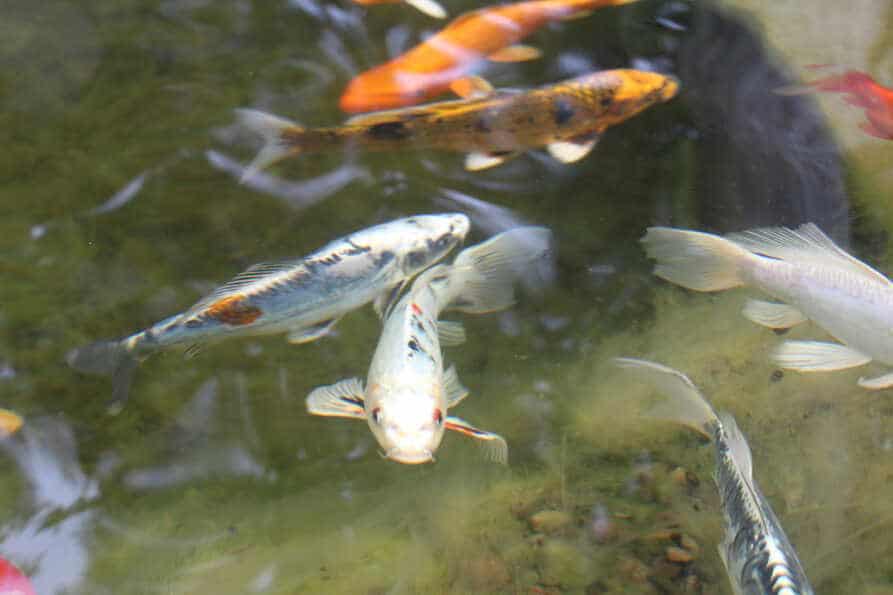

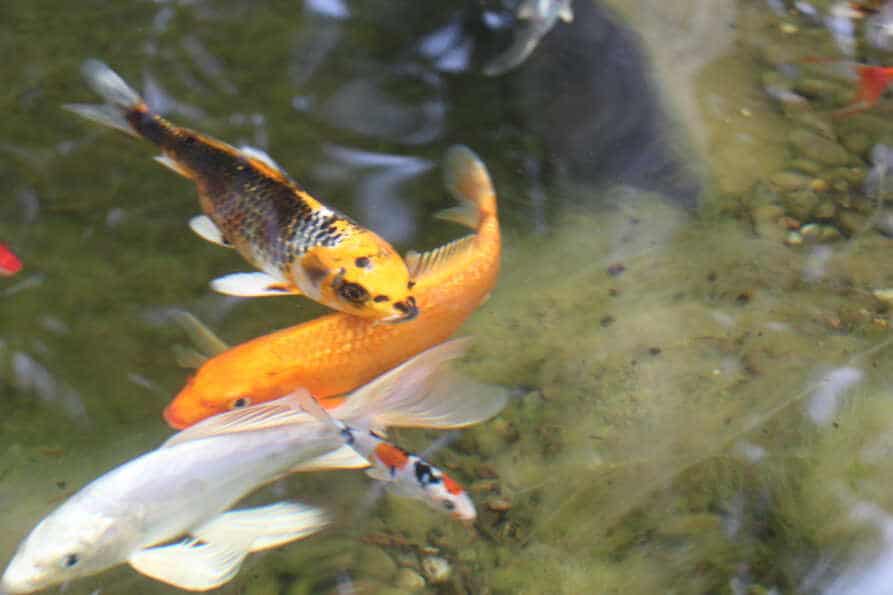



I absolutely love the beauty and tranquility of a well-put together koi pond. I recently moved into a new home, and quickly noticed a couple of places that were perfect for putting in a koi pond. My sweetie’s first reaction to the idea was a strong no. I had to push to figure out what was holding him back, and he basically brought up your main points: keeping water fresh for them, size required, and all of the the hawks and owls that live in the area. These combined with the time and money investment that would be required have led us to the conculsion that we will stick to enjoying other people’s koi ponds for now. Thanks for the article… it’s important information to know!!
When I was a kid we had a fish tank at home. Compared to that a koi pond is much more complicated. I didn’t realize how much water was required and the depth of the pond. When the filtration system is added, it’s quite an expensive proposition. I suppose the beauty of the fish swimming around makes it worth the cost and effort.
A koi pond is great for a restaurant or business but definitely not for our home. Great article that taught me a lot about koi.